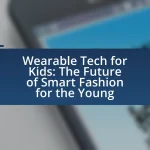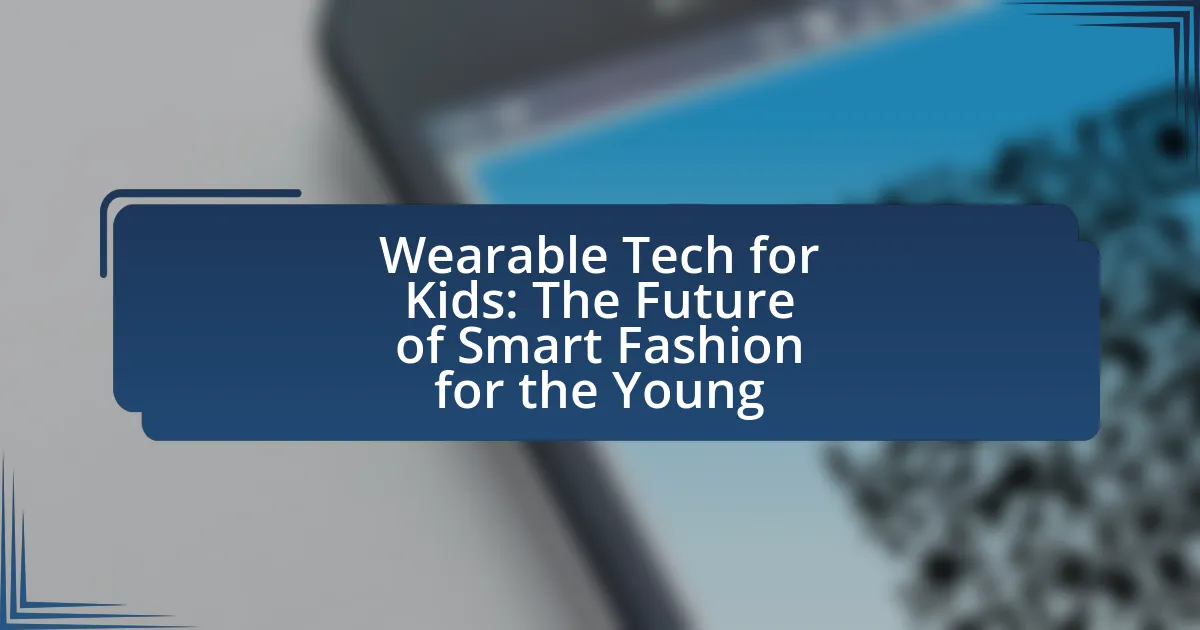The article explores the intersection of fashion design and wearable technology, highlighting how innovative textiles and smart devices are integrated into clothing and accessories to enhance functionality while maintaining aesthetic appeal. It discusses the mutual influence between fashion and technology, key elements that facilitate this integration, and emerging trends such as smart textiles and sustainable materials. Additionally, the article addresses the impact of wearable technology on consumer behavior, current innovations in the field, and the challenges designers face in merging these two domains. It concludes by outlining best practices for integrating wearable technology into fashion and providing tips for consumers on selecting suitable wearable items.

What is the Intersection of Fashion Design and Wearable Technology?
The intersection of fashion design and wearable technology involves the integration of innovative textiles and smart devices into clothing and accessories, enhancing functionality while maintaining aesthetic appeal. This convergence allows designers to create garments that not only serve traditional fashion purposes but also incorporate features such as health monitoring, connectivity, and interactive capabilities. For instance, brands like Ralph Lauren have developed smart shirts that track biometric data, demonstrating how fashion can embrace technology to improve user experience and personal health.
How do fashion design and wearable technology influence each other?
Fashion design and wearable technology influence each other by integrating aesthetics with functionality, leading to innovative products that enhance user experience. Designers incorporate technology into garments to create smart clothing that monitors health metrics, while technologists draw inspiration from fashion trends to develop more appealing devices. For instance, the collaboration between fashion brands and tech companies has resulted in products like smartwatches and fitness trackers that not only serve practical purposes but also align with current fashion aesthetics, as seen in partnerships like Apple and Hermès. This synergy fosters a market where both sectors evolve, pushing boundaries in design and technology.
What are the key elements of fashion design that integrate with wearable technology?
The key elements of fashion design that integrate with wearable technology include functionality, aesthetics, user experience, and material innovation. Functionality ensures that the wearable technology serves a practical purpose, such as health monitoring or connectivity, while aesthetics focuses on the visual appeal and style of the garment. User experience encompasses how the wearer interacts with the technology, ensuring it is intuitive and comfortable. Material innovation involves the use of advanced fabrics and sensors that can seamlessly incorporate technology without compromising the garment’s design. These elements collectively enhance the usability and desirability of wearable technology in fashion.
How does wearable technology enhance the functionality of fashion design?
Wearable technology enhances the functionality of fashion design by integrating smart features into clothing and accessories, allowing them to perform tasks beyond traditional aesthetics. This integration enables garments to monitor health metrics, provide connectivity to devices, and adapt to environmental conditions, thereby increasing their utility. For instance, smart textiles can track heart rate or body temperature, while connected accessories can receive notifications or control smart home devices. The rise of wearable technology in fashion has led to innovations such as fitness trackers embedded in clothing and jackets that can change color based on temperature, demonstrating a significant shift towards multifunctional apparel.
Why is the intersection of fashion design and wearable technology important?
The intersection of fashion design and wearable technology is important because it enhances functionality while maintaining aesthetic appeal. This convergence allows for the creation of garments that not only serve traditional fashion purposes but also incorporate features such as health monitoring, connectivity, and user interactivity. For instance, smart textiles can monitor vital signs or adjust temperature, providing practical benefits that align with contemporary lifestyle needs. The global wearable technology market is projected to reach $60 billion by 2023, indicating a significant consumer interest in products that blend style with technology. This trend underscores the necessity for designers to innovate at this intersection, ensuring that fashion remains relevant in an increasingly tech-driven world.
What trends are emerging at the crossroads of these two fields?
Emerging trends at the intersection of fashion design and wearable technology include the integration of smart textiles, sustainable materials, and personalized fashion experiences. Smart textiles, such as fabrics embedded with sensors, enable functionalities like health monitoring and temperature regulation, enhancing user experience. Sustainable materials are increasingly being utilized to create eco-friendly wearables, reflecting consumer demand for environmentally responsible fashion. Additionally, personalized fashion experiences are facilitated through data-driven design, allowing for customized fits and styles based on individual preferences and biometric data. These trends are supported by industry reports indicating a growing market for smart clothing, projected to reach $4 billion by 2025, highlighting the significant consumer interest in this convergence of technology and fashion.
How does this intersection impact consumer behavior and preferences?
The intersection of fashion design and wearable technology significantly impacts consumer behavior and preferences by enhancing functionality while maintaining aesthetic appeal. Consumers increasingly seek products that not only serve practical purposes, such as health monitoring or connectivity, but also align with their personal style and fashion sensibilities. For instance, a study by McKinsey & Company in 2021 found that 70% of consumers are more likely to purchase wearable technology if it is designed to be fashionable, indicating a strong preference for products that blend utility with style. This trend drives brands to innovate, leading to a greater variety of stylish wearable options that cater to diverse consumer tastes, ultimately shaping purchasing decisions and brand loyalty.

What are the current innovations in wearable technology within fashion design?
Current innovations in wearable technology within fashion design include smart textiles that integrate sensors for health monitoring, augmented reality (AR) for virtual fitting rooms, and garments that adapt to environmental conditions. Smart textiles, such as those developed by companies like Wearable X, incorporate sensors that track biometric data, enabling users to monitor their health in real-time. Augmented reality applications, like those from brands such as Zara, allow customers to visualize how clothing fits without trying it on physically, enhancing the shopping experience. Additionally, adaptive clothing, such as jackets with built-in heating elements from brands like The North Face, respond to temperature changes, providing comfort and functionality. These innovations demonstrate the growing synergy between technology and fashion, enhancing user experience and functionality.
How are designers incorporating technology into their collections?
Designers are incorporating technology into their collections by integrating smart textiles and wearable devices that enhance functionality and user experience. For instance, brands like Ralph Lauren and Levi’s have developed clothing with built-in sensors that monitor health metrics or allow users to control devices through gestures. Additionally, advancements in 3D printing enable designers to create intricate patterns and customized fits, as seen in the work of Iris van Herpen, who utilizes this technology to produce avant-garde pieces. These innovations not only push the boundaries of traditional fashion but also cater to the growing demand for interactive and personalized clothing solutions.
What types of wearable technology are most commonly used in fashion?
The most commonly used types of wearable technology in fashion include smartwatches, fitness trackers, smart clothing, and augmented reality (AR) glasses. Smartwatches, such as the Apple Watch and Samsung Galaxy Watch, integrate health monitoring and communication features into stylish designs. Fitness trackers, like Fitbit, focus on health metrics and activity tracking while being designed for everyday wear. Smart clothing incorporates sensors and technology directly into fabrics, enabling functionalities like temperature regulation and biometric monitoring. AR glasses, such as Google Glass, offer interactive experiences and information overlays, merging digital content with the physical world. These technologies are increasingly adopted in fashion to enhance user experience and functionality while maintaining aesthetic appeal.
How do these innovations change the way we perceive fashion?
Innovations in wearable technology fundamentally alter our perception of fashion by integrating functionality with aesthetics. This fusion allows consumers to view clothing not just as a style statement but also as a tool for enhancing daily life, such as through health monitoring or connectivity features. For instance, smart textiles can track biometric data, which shifts the focus from traditional fashion elements to performance and utility. According to a report by McKinsey & Company, the global market for smart clothing is projected to reach $4 billion by 2025, indicating a growing acceptance and demand for these innovations in everyday wear. This trend signifies a transformation in consumer expectations, where fashion is increasingly seen as a blend of style, technology, and practicality.
What challenges do designers face when merging fashion and technology?
Designers face significant challenges when merging fashion and technology, primarily due to the need for seamless integration of aesthetics and functionality. The complexity of incorporating advanced materials and electronics into wearable designs often leads to issues with comfort, durability, and user experience. For instance, the integration of sensors and batteries can compromise the garment’s fit and style, making it less appealing to consumers. Additionally, the rapid pace of technological advancement can result in obsolescence, where designs quickly become outdated, creating a challenge for designers to stay relevant. Furthermore, there are often high production costs associated with developing innovative materials and technologies, which can limit accessibility and scalability in the fashion market.
How do technical limitations affect design choices?
Technical limitations significantly influence design choices by constraining the materials, functionalities, and aesthetics that designers can employ. For instance, the battery life of wearable technology often dictates the size and weight of the device, which in turn affects the overall design and comfort of the wearable. Additionally, limitations in sensor technology can restrict the types of data that can be collected, thereby influencing the features that can be integrated into the design. A study by the Fashion Institute of Technology highlights that designers must balance innovation with the practical constraints of technology, ensuring that the final product is both functional and appealing to consumers.
What are the ethical considerations in wearable technology fashion?
The ethical considerations in wearable technology fashion include privacy, data security, environmental impact, and labor practices. Privacy concerns arise as wearable devices often collect sensitive personal data, necessitating robust data protection measures to prevent unauthorized access. Data security is critical, as breaches can lead to identity theft or misuse of personal information. Environmental impact is significant, as the production and disposal of electronic components contribute to e-waste, prompting the need for sustainable practices in manufacturing. Labor practices also warrant attention, as ethical sourcing and fair labor conditions are essential in the production of wearable technology. These considerations highlight the need for a responsible approach in the integration of technology and fashion.

How can consumers benefit from the intersection of fashion design and wearable technology?
Consumers can benefit from the intersection of fashion design and wearable technology through enhanced functionality, personalized experiences, and improved health monitoring. Wearable technology, such as smartwatches and fitness trackers, integrates seamlessly with stylish designs, allowing consumers to access features like notifications, health metrics, and fitness tracking without sacrificing aesthetics. For instance, a study by the Consumer Technology Association found that 70% of consumers are more likely to purchase wearable devices that combine style with technology, indicating a strong market demand for fashionable wearables. This integration not only promotes a more active lifestyle but also encourages users to engage with their health data in a visually appealing manner, ultimately leading to better health outcomes and increased consumer satisfaction.
What practical applications do wearable technologies offer to consumers?
Wearable technologies offer consumers practical applications such as health monitoring, fitness tracking, and enhanced connectivity. These devices, including smartwatches and fitness bands, enable users to track vital signs like heart rate and sleep patterns, which can lead to improved health outcomes. For instance, a study published in the Journal of Medical Internet Research found that wearable fitness trackers can significantly increase physical activity levels among users. Additionally, wearables facilitate seamless communication by allowing users to receive notifications and messages directly on their devices, enhancing convenience in daily life.
How can wearable technology improve daily life and personal style?
Wearable technology can enhance daily life and personal style by integrating functionality with fashion, allowing users to monitor health metrics, receive notifications, and express individuality through design. Devices like smartwatches and fitness trackers provide real-time health data, which can lead to improved wellness and informed lifestyle choices. For instance, a study published in the Journal of Medical Internet Research found that wearable devices can increase physical activity levels by up to 30%. Additionally, fashion-forward wearables, such as smart jewelry and designer fitness bands, enable users to maintain their personal style while benefiting from technology, thus merging aesthetics with practicality.
What are the potential health benefits of wearable fashion technology?
Wearable fashion technology offers several potential health benefits, including improved fitness tracking, enhanced health monitoring, and increased motivation for physical activity. These devices, such as smartwatches and fitness trackers, can monitor vital signs like heart rate, sleep patterns, and physical activity levels, providing users with real-time data to manage their health effectively. For instance, a study published in the Journal of Medical Internet Research found that individuals using wearable devices were more likely to engage in regular physical activity, leading to better overall health outcomes. Additionally, wearable technology can facilitate early detection of health issues, allowing for timely medical intervention, which is supported by research from the American Heart Association indicating that continuous heart rate monitoring can help identify arrhythmias.
What are some best practices for integrating wearable technology into fashion?
Best practices for integrating wearable technology into fashion include prioritizing user comfort, ensuring seamless functionality, and focusing on aesthetic appeal. User comfort is essential, as wearable technology must not hinder movement or cause discomfort; for instance, materials should be lightweight and breathable. Seamless functionality is crucial, meaning that the technology should integrate smoothly with the garment without requiring complex user interactions; successful examples include smartwatches that sync effortlessly with clothing. Aesthetic appeal is vital, as the design must align with current fashion trends to attract consumers; brands like Ralph Lauren have successfully combined style with technology in their smart clothing lines. These practices ensure that wearable technology enhances the user experience while maintaining the integrity of fashion design.
How can designers ensure user-friendly experiences with wearable tech?
Designers can ensure user-friendly experiences with wearable tech by prioritizing intuitive interfaces and ergonomic designs. Intuitive interfaces allow users to navigate features easily, which is crucial given that wearables often have limited screen space. Ergonomic designs enhance comfort and usability, ensuring that the device fits well and can be worn for extended periods without discomfort. Research indicates that 70% of users abandon wearable devices due to poor usability, highlighting the importance of these design principles. By focusing on user feedback during the design process, designers can refine features and functionalities to better meet user needs, ultimately leading to a more satisfying experience.
What tips can consumers follow to choose the right wearable fashion items?
Consumers should prioritize functionality, style, and comfort when choosing wearable fashion items. Selecting items that seamlessly integrate technology with aesthetic appeal ensures both practicality and visual appeal. For instance, wearables like smartwatches should not only offer features such as fitness tracking but also complement personal style, as evidenced by the popularity of brands like Apple and Fitbit, which combine sleek designs with advanced functionalities. Additionally, consumers should consider the materials used in wearable items, as breathable and lightweight fabrics enhance comfort during extended wear. Research indicates that 70% of consumers value comfort in wearable technology, highlighting its importance in the selection process.





